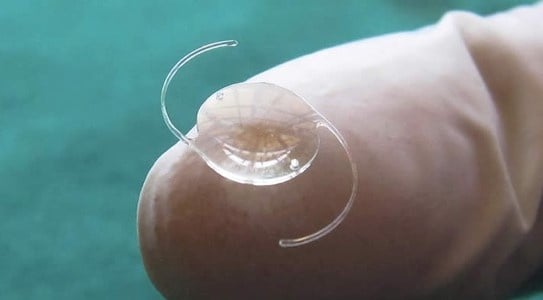Cataracts? Understand your lens implant options
What the heck is an IOL? Available since the early 1980's, lens implants or as they are known in the ophthalmic world, Intraocular Lenses or "IOLs",...
2 min read
 The Rochester Eye & Laser Team
:
Feb 28, 2020 3:11:19 PM
The Rochester Eye & Laser Team
:
Feb 28, 2020 3:11:19 PM

Upon completion of a thorough eye exam, your eye doctor may have mentioned that you are nearsighted or farsighted, or even diagnosed you with astigmatism, then handed you a prescription for eyeglasses.
(If you are in need of an eye exam, click here to schedule with one of our eye doctors.)
When you look at the numbers and letters in the graph on the paper, what does it say? Our blog will help you understand the acronyms, symbols and numbers printed on your prescription, so you can better discuss your options with your optician.

O.D. & O.S.
Let’s start at the beginning with O.D. and O.S. These are the abbreviations for oculus dexter and oculus sinister. Sounds kind of creepy right? It’s not, I assure you. These are simply Latin terms for “right eye” and “left eye,” and although use of these terms is still common, many eye doctors have updated their forms opting to use RE (right eye) and LE (left eye).
SPHERE
The section on your prescription labeled ‘sphere’ refers to the lens power needed to correct either nearsightedness or farsightedness. If the number listed has a plus sign (+) you are farsighted. If the number listed has a minus sign (-) you are nearsighted. The higher the number after the + or - sign, the stronger the prescription.
CYL & AXIS
CYL, or Cylinder, and AXIS refer to the specific curvature of the lenses needed to correct the diagnosed astigmatism. Some people may find these fields blank; this means that there is little to no astigmatism in need of correction. As with sphere, the numbers in the CYL column may be accompanied by a + (for farsighted astigmatism) or a – (for nearsighted astigmatism). The CYL number represents the severity of the astigmatism, while the AXIS number tells you its orientation.
ADD
Prescriptions for bifocal and multifocal lenses have numbers in the ADD fields. This number denotes the magnifying power that is added to the bottom portion of bi and multifocal lenses, to correct presbyopia, or age-related farsightedness.
 There are many other facts about eyeglass prescriptions that you may not know. For instance, you may not use your eyeglass prescription to purchase contact lenses. Since eyeglass prescriptions and contact lens prescriptions are not the same, an additional contact lens consultation and fitting are required to obtain a separate contact lens prescription.
There are many other facts about eyeglass prescriptions that you may not know. For instance, you may not use your eyeglass prescription to purchase contact lenses. Since eyeglass prescriptions and contact lens prescriptions are not the same, an additional contact lens consultation and fitting are required to obtain a separate contact lens prescription.
Also, your eyeglass prescription belongs to you. After any eye exam that includes refraction, your eye doctor is required, by law, to provide you with a copy of your prescription, whether you ask for it or not. This allows you the opportunity to purchase your glasses anywhere you choose, not just in the shop that performed your eye exam.
Now you understand what those strange numbers on your eyeglass prescription mean, so it’s time to make sure your eye exam and prescription are up-to-date. If they’re not, click here to schedule an eye exam.

What the heck is an IOL? Available since the early 1980's, lens implants or as they are known in the ophthalmic world, Intraocular Lenses or "IOLs",...

1 min read
Are you considering LASIK surgery OVER age 45? Do you currently wear reading glasses, bifocals, or readers over your contact lenses for near...

Are you one of the many people who are confused about the difference between optometrist and ophthalmologist? You might think the terms are...